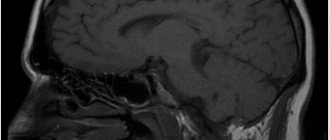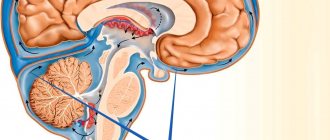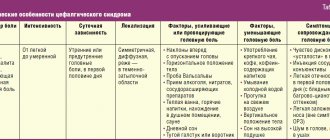Venous encephalopathy is a common condition of the cerebral vascular system, in which there is a violation of the venous outflow of blood from the brain. Moreover, this disease can be combined with arterial problems and so-called discirculatory encephalopathy (the author uses the words “so-called” due to the fact that venous encephalopathy is also inherently a discirculatory process), or it can be an independent disease.
Information for doctors. According to ICD 10, there is no diagnosis of venous encephalopathy. Because of this, to more accurately indicate the presence of a venous problem, it is more logical to use codes M53.0 (cervicocranial syndrome) and indicate that problems with the cervical spine led to this condition, leading to the diagnosis description of chronic venous outflow disorder syndrome, or indicate this syndrome within the framework of diagnosis I67.8 - discirculatory encephalopathy - in the event that this diagnosis also occurs.
At the moment, venous dysfunction is a controversial condition, not recognized by a number of authors, however, the clinical practice of the author of the site shows the importance of the presence of disturbances in the venous outflow from the cranial cavity in the formation of various symptoms.
A little about venous encephalopathy
Venous encephalopathy develops in the presence of chronic disorders of the venous outflow of blood from the brain. Due to this condition, the production of cerebrospinal fluid changes, intracranial pressure increases, and metabolic processes are disrupted. There are many reasons for this. Among them, the most common are hereditary structural features of the vein wall, cervical compression syndromes, residual dysontogenetic background (vascular hypoplasia, etc.). Less commonly, these processes arise from such reasons as the consequences of an inflammatory process in the veins and sinuses (for example, after sinus thrombosis), compression by a brain tumor, or trauma to the skull, including birth trauma.
Venous encephalopathy itself as a disease does not pose a threat to the patient’s life. However, its presence can significantly worsen the quality of life, reduce ability to work, and worsen the prognosis in the presence of other somatic diseases.
Diagnostics
In order to make a diagnosis of venous encephalopathy, the doctor must assess the patient’s general condition and listen to his complaints. You can talk about a possible disease if there are 5 subjective signs:
- characteristic headache ;
- dizziness that occurs when changing body position;
- noise in the head or ears;
- visual problems (decreased visual acuity, photophobia);
- symptom of “tight collar” , sleep disturbances.
In some cases, the doctor may focus on symptoms such as swelling, expansion of the saphenous veins of the neck and face.
Impaired blood flow in the veins of the brain is almost always secondary in nature and is a consequence of the underlying disease, so diagnosis is primarily aimed at identifying it.
When a patient is examined:
- on days with favorable geomagnetic conditions;
- during a period when there were no complaints of poor health and headache for at least 3 days;
- in women in the first half the menstrual cycle.
It should be taken into account that venous circulation is extremely labile and the results of the study can be affected by the patient’s posture, muscle activity, and breathing
Diagnostic methods:
- General and biochemical blood test.
- Analysis of urine.
- Ophthalmoscopy – examination of the fundus of the eye, the condition of the retinal vessels, determination of intraocular pressure.
- Ultrasound examination of the venous system of the brain.
- Computer and magnetic resonance imaging of the brain.
- Ultrasound duplex scanning (USDS) - allows you to evaluate the speed of blood flow.
- Electrocardiography (ECG).
- Echocardiography (ECHO-CG).
- Electroencephalography (EEG).
- Selective contrast venography (examination of veins by introducing a contrast agent into the blood).
- Scintigraphy (injection of radioactive isotopes into the body to obtain a two-dimensional image).
For a comprehensive study of the disease, it is best to undergo examination by all specialists who are in one way or another related to this problem.
Symptoms and diagnosis of venous encephalopathy
The symptoms of venous encephalopathy are varied, often they resemble other diseases (dyscirculatory process, problems with the cervical spine, depression, etc.). The most typical “venous” complaints are the following symptoms:
- Morning (sometimes night) headaches of a bursting nature
- Dizziness, which is non-systemic in nature, worsens when changing body position,
- Noise in the head, especially when going to bed
- Visual disturbances (a progressive decrease in visual acuity and various photopsia may be noted)
- Feeling of discomfort in the eyes in the morning
Symptoms are aggravated by working at an incline, wearing narrow collars and ties, and sleeping on a low surface. Objectively, the following signs may also be noted:
- Pastosity (swelling) of the face and eyelids in the morning (with a pale or bluish tint)
- Mild nasal congestion
Conditions after which the complaints intensify are also characteristic: bending forward with lowering the head, horizontal position of the body, taking alcohol-containing drinks, nitrates, vasodilators, warm bath or sauna, hot drinks, being in a stuffy room, daytime sleep. Or, on the contrary, they decrease: drinking caffeine-containing drinks, rinsing in cold water, walking in the fresh air, vertical body position, sleeping strictly on a high pillow.
A neurological examination is important, which, however, also does not have cardinal diagnostic signs. The neurological status reveals the following symptoms: nystagmus is expected, there is convergence insufficiency of the eyeballs, decreased corneal reflexes (rarely tested), pain in the exit points of the branches of the trigeminal nerve, decreased sensitivity in the area of innervation of the first trigeminal nerve, dissociation (difference between) knee and Achilles reflexes, impaired coordination when walking.
Diagnostic methods include a set of the following examinations: ophthalmological examination, which allows to identify congestion in the retina, dilated retinal veins, ultrasound examination of the veins of the neck and brain, MRI venography (if necessary, with the introduction of a contrast agent). A relative study that can help in the absence of the above methods is rheoencephalography, which allows one to evaluate microcirculation and venous outflow. The presence of diastolic index values below normal may make you think about the presence of venous disorders.
However, there are no clear diagnostic criteria. In 90% of cases, the diagnosis is made on the basis of complaints, anamnesis, and neurological examination data, focusing on the research methods carried out (if possible).
Ideally, for a reliable diagnosis, it is necessary to combine the presence of all the above-described signs of the disease along with the absence of other reliable reasons for the development of the patient’s complaints.
Symptoms
There are many reasons for the appearance of cerebral encephalopathy, and therefore its manifestations differ. They depend on why it develops, where it is localized in the brain and what the nature of the lesion is. However, a common feature is a slow or rapid change in mental status.
For example, hepatitis contributes to a mild change: the patient cannot draw simple designs, that is, he develops apraxia - the inability to make complex movements, purposeful actions. But brain anoxia is a sharp lack of oxygen that leads to death within a few minutes.
Symptoms of encephalopathy include poor coordination of movements, inability to concentrate, inattention, as well as more serious manifestations:
- tremor of the limbs;
- lethargy;
- breathing disorder – it becomes periodic;
- muscle pain, twitching;
- convulsions;
- numbness of the nose, lips, fingertips;
- fainting, dizziness;
- persistent headaches or acute attacks;
- noise in the head;
- sleep disturbance;
- decreased thinking abilities, memory;
- sudden change of mood;
- decreased sex drive;
- apathy;
- fatigue and constant weakness;
- depression;
- sluggishness of speech;
- irritability;
- nausea, vomiting;
- coma.
If treatment is not started in time, the symptoms will intensify, hallucinations, delusions, disorders of consciousness, psychosis, etc. may appear, and there is a risk of death.
Dizziness due to venous encephalopathy
Dizziness with venous encephalopathy has characteristic differences. It occurs after a change in body position, passes quickly enough in an upright position, and intensifies in the morning. However, this symptom can also be provoked by other factors that would also provoke it in other diseases: alcohol intake, a jump in blood pressure, etc.
Objectifying the presence of dizziness due to impaired venous outflow is difficult. Patients are checked for accuracy when performing corrdinator tests, Romberg test is performed, nystagmus is checked while standing and then in a lying position. Increased nystagmus while lying down may also indicate disturbances in venous outflow.
Dizziness with venous encephalopathy does not pose any threat to life. As a rule, treatment quickly relieves this symptom.
What is venous encephalopathy
Venous encephalopathy is a vascular pathology of the brain that interferes with the normal outflow of venous blood. At the same time, brain cells begin to experience constant oxygen starvation and in advanced cases may begin to die. Encephalopathy is most often an accompanying disease, so it is advisable to determine the underlying cause and begin treatment for the underlying cause.
Venous encephalopathy is a non-inflammatory degenerative lesion of brain tissue that occurs when the outflow of venous blood is disrupted.
In this case, hypoxia of neurons occurs, manifested by fatigue, dizziness, pain of varying intensity, blurred vision and other disorders.
Treatment is aimed at correcting the underlying disease and relieving symptoms.
The pathology can be diagnosed at any age. Some people live their entire lives with this problem, but only discover the cause after a thorough medical examination and tests for other underlying conditions.
Venous discirculation is characterized by clinical symptoms of a “tight collar”, “high pillow” (increased symptoms when wearing tight collars, sleeping on a low pillow), a feeling of “sand in the eyes” in the morning, the symptoms are most pronounced in the morning and night hours.
The headache is characterized by a monotonous, leaden character, intensified by bending forward, taking vasodilators, visiting saunas, stuffy rooms.The triad for typical venous encephalopathy includes morning facial swelling, facial cyanosis, and dilated saphenous veins of the face and neck.
Neurologist
Pershina Natalia Sergeevna
8 years of experience
Treatment of venous encephalopathy
To begin with, I would like to note the groups of drugs that are best not to be used for venous encephalopathy, as they can cause a deterioration in well-being. These include antihypertensive drugs of the group of calcium channel blockers, nitroglycerin, nicotinic acid. These drugs, causing dilatation of the veins, only worsen the reasons that led to the pathological condition.
The drugs of choice for venous encephalopathy are venotonics, both for intravenous administration (L-lysine escitate, also known as horse chestnut salt, escin and amino acids), and for oral administration, these include Antistax, Troxevasin, Detralex, Phlebodia. The author of the site prefers to prescribe Detralex, although the choice of drug is the prerogative of the attending physician.
In addition, vasoactive drugs (Tanakan, Cavinton, Trental), metabolic agents (Mexidol), and specific diuretics that reduce the level of intracranial pressure (Diacarb, Mannitol) are used. Symptomatically, betahistine drugs, NSAIDs (especially for problems with the cervical spine), muscle relaxants (allow you to relieve spasm of the spinal muscles that impede venous outflow) can be used.
However, you should not bypass non-drug methods of treating the problem: exercise therapy, maintaining a correct lifestyle, limiting provoking factors (alcohol, bending work, etc.).
Venous encephalopathy, if diagnosed in a timely manner, responds quite well to treatment. Remember, your health is in your hands, and doctors can help restore it; it is only important to follow all the recommendations. Be healthy!









